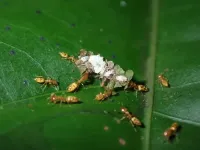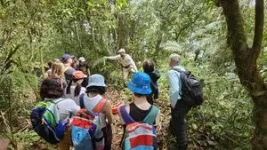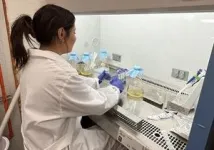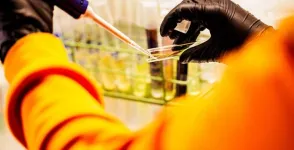(Press-News.org) Ants are famous for their regimented and complex social behaviors. In the tropics, they are also famous for forming mutualisms with plants. Certain species of trees have conspicuous hollow swellings that house ants, often feeding the ants with specialized ant food. In return, the ants are pugnacious bodyguards, swarming out to aggressively defend the plant against enemies. Scientists have observed these mutualisms for centuries, but an enduring question is how these intriguing interactions evolved in the first place.
That remains a mystery, but new research led by University of Utah field biologist Rodolfo Probst offers insights that could broaden our understanding of ant-plant symbioses.
Published last week in the Proceedings of the Royal Society B, his research focused on an ant genus called Myrmelachista. Most Myrmelachista species nest in dead or live stems of plants, without any specialized mutualistic association. But one group of species in Central America was known to nest only in the live stems of certain species of small understory trees, in a specialized symbiosis similar to other ant-plant mutualisms. These tiny yellow ants hollow out the stems without harming the host plants, and can be found throughout Central America.
Such symbiosis requires complex and novel behaviors and morphology (physical characteristics such as color, shape and size), and is thought to occur infrequently. The Central American specialists were a cluster of nine species that all shared these complex traits and were only slightly different from each other. It was assumed that a single common ancestor must have evolved the symbiosis over a long period of time, and these were very young species that had emerged after the symbiosis had evolved.
Probst made a remarkable discovery. Using DNA sequence data to unravel their evolutionary history, he found that these nine species occurred as two clusters in different parts of the evolutionary tree. That means that this complex relationship, with all its distinctive characteristics, evolved twice from non-specialist ancestors. Not only that, but they also evolved in close proximity, and at about the same time, around 3 million years ago.
“I wish I could just take a time machine and see it,” Probst said. “Maybe it was the ecology or plant availability that helped those friendships evolve in the first place.”
He argues this is a case of convergent evolution, where unlike species evolve to be more similar, often because they occupy similar specialized ecological niches. Think whales and fish. Somehow, these ants developed the same behavior in what Probst dubbed “evolutionary déjà vu.”
“They look so similar that the parsimonious assumption was that this mutualism might have evolved once,” Probst said. “The coolest part of our paper is that we’re showing that these types of ant-plant friendships evolve multiple times independently. Is that evolutionary déjà vu? It’s like if it happens, it might happen again if you’re given the appropriate ecological conditions.”
His two coauthors are renowned entomologist Jack Longino, better known among U students as The Astonishing Ant Man for his expertise and vast personal collection of ant specimens kept on campus, and former U School of Biological Sciences’ postdoctoral researcher Michael Branstetter, now with U.S. Department of Agriculture’s Pollinating Insect Research Unit at Utah State University.
“The main story in this paper is the unexpected part. Rodolfo’s work revealed two independent evolutions of a complex relationship with plants. It suggests that the developmental building blocks for very distinctive or complex features are readily at hand, and can quickly evolve among different sets of species when the conditions arise,” said Longino, a U professor of biology who has spent more than four decades studying ants, mostly in tropical regions. “Morphology alone has never been good at revealing relationships among species, the evolutionary pageant that is how life has diversified on the planet.”
Probst is a postdoctoral researcher in the School of Biological Sciences and the university’s Science Research Initiative, or SRI, and was recently recognized with the Outstanding Postdoctoral Researcher Award by the College of Science. Through the SRI, Probst has involved U undergraduates in his research. For example, students accompanied Probst and Longino to Costa Rica with funding support from the U’s Wilkes Center for Climate Science & Policy. While there, the group conducted fieldwork in the San Gerardo Station, part of the Bosque Eterno de los Niños (Children’s Eternal Rainforest)] nature reserve.
With continuing help from SRI undergraduates, Probst is looking to conduct whole genomic sequencing to tease out the genes involved in ant-plant associations, looking “under the hood” of a phenomenon that has intrigued naturalists for centuries.
######
Probst’s study, titled “Evolutionary déjà vu? A case of convergent evolution in an ant–plant association,” appeared July 9 in the Proceedings of Royal Society B. Coauthors are Jack Longino and Michael Branstetter. Funding came from the National Science Foundation, Society of Systematic Biologists, The Linnaean Society and the Center for Latin American Studies at the University of Utah.
END
TAMPA, Fla. — The recent U.S. Food and Drug Administration approval of lifileucel, the first commercial tumor-infiltrating lymphocyte (TIL) therapy for advanced melanoma, marks a significant breakthrough in cancer therapy. In a new commentary published in Cancer Cell, Moffitt Cancer Center scientists provide a comprehensive overview of the therapy’s development and highlight its transformative potential.
“TIL therapy represents a major advancement in personalized cancer treatment, offering new possibilities for patients with treatment-resistant cancers,” said Amod Sarnaik, M.D., ...
FOR IMMEDIATE RELEASE: July 18, 2024
CONTACT: Camille Jewell, cjewell@vancomm.com or 202-248-5460
COLORADO SPRINGS, Colo. — Neurointerventional surgeons from across the globe will gather at the Society of NeuroInterventional Surgery’s (SNIS) 21st Annual Meeting from July 22 through July 25 in Colorado Springs, Colorado, to present novel research and innovation in their field.
The conference, held at the Broadmoor Resort, will be a hybrid event with in-person and livestreamed content. Meeting sessions will cover new topics ranging from how living in coal mining areas worsens outcomes ...
Researchers from the University of Tennessee Health Science Center College of Medicine-Knoxville; the University of Tennessee, Knoxville; and the University of Tennessee Health Science Center Office of Research understand the challenges affecting the health and wellness of Tennesseans. A new system-wide collaborative grant program led by UTHSC COM-K is supporting research and scholarly activities to pursue discoveries addressing health issues across Tennessee and beyond.
The program will fund six awards totaling more than $450,000 to support teams of clinicians, faculty, and researchers from across the state to innovate in the field of medicine and biomedical research.
Robert ...
A team of University of Virginia researchers released the first-ever database of hurricane evacuation orders in the United States. By examining what has worked (and hasn’t) in the face of oncoming hurricanes, leaders and government officials can increase community resilience, create better policy and, ultimately, reduce loss of life.
The project, seed-funded by UVA’s Environmental Institute, teamed Majid Shafiee-Jood and Negin Alemazkoor and Harsh Anand, an engineering doctoral candidate, from the School of Engineering and Applied Science. The trio spent countless hours gathering all nationwide public-facing evacuation orders and created a database that can ...
The Center for Applied Biomechanics at the University of Virginia studies the impact of car crashes on the human body, aiming to improve injury prevention. Funded by Toyota’s Collaborative Safety Research Center, CAB’s three newest projects will study rib, lumbar and ankle injuries specifically.
Jason Forman, a UVA Engineering and Applied Science research associate professor in the Department of Mechanical and Aerospace Engineering, is the principal investigator on two of the studies.
One study will use ...
A multitude of new genomic sequence data fills major gaps in the fruit fly tree of life, Bernard Kim from Stanford University, US, and colleagues report in the open-access journal PLOS Biology, publishing July 18th.
Fruit flies are classic model organisms in biological research and were among the first species to have their whole genome sequenced. With over 4,400 species, the diversity of the fruit fly family could offer insights into evolutionary patterns and processes. But only a fraction of these species ...
A large-scale genome-wide association study (GWAS) using data from the United States Department of Veterans Affairs (VA) Million Veterans Program (MVP) – one of the largest US-based biobanks – fills crucial gaps in our knowledge of the relationships between genes, traits, and disease across diverse populations, according to a new study. The findings underscore the importance of diversity in genetic studies and the need for expanding representation in future GWAS investigations. GWAS studies have provided foundational knowledge about the genetic basis of disease ...
When at the edges of their geographic ranges, fruit-eating birds favor foods that more closely match their beak size, researchers report, suggesting that foraging niches (the diversity of food resources a species uses) become more specialized toward the periphery of a species range. The findings may help explain geographic variation in species’ fitness and are important for accurately predicting species’ responses to continued environmental change, which is forcing many populations to live near or outside their historic range limits. Animals feed on a subset of available resources within their environment. Optical ...
In a Perspective, Daniel Drucker highlights the growing body of evidence that hints at the potential of glucagon-like peptide-1 (GLP-1)-based medications in treating conditions other than diabetes and obesity, including cardiovascular disease and neurodegenerative disorders. GLP-1 is a hormone released from the gut after eating that enhances glucose-dependent insulin secretion. Pharmacological GLP-1 receptor (GLP-1R) activation reduces glucagon secretion and slows gastric emptying, making it an effective treatment for type 2 diabetes. Later studies found that GLP-1 administration also inhibited food intake through ...
Artemisinin-based combination therapies (ACTs) have become the cornerstone of malaria treatment and control. However, the recent emergence and spread of artemisinin-resistance (ART-R) in malaria-causing Plasmodium falciparum parasites in eastern Africa has compromised the efficacy of these crucial treatments. In a Policy Forum, Mehul Dhorda and colleagues argue that urgent action is needed to prevent a surge in malaria-related sickness and death in the region. “Success in containing ART-R in the Greater Mekong Subregion in Asia, where ART-R was first reported in 2008, suggests that a multipronged approach is needed ...






